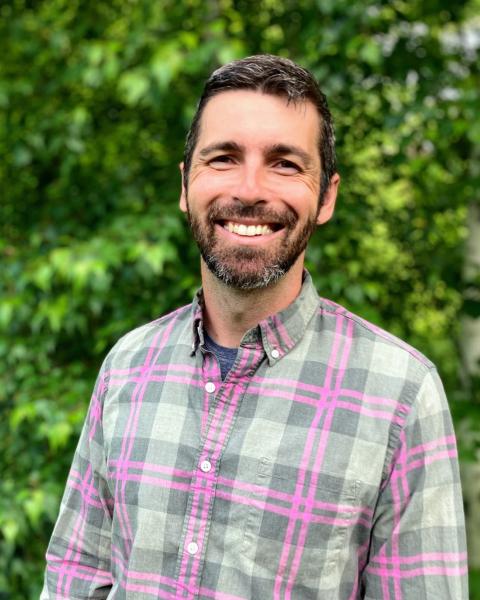Key Findings

High moisture stress and low winter hardiness have prevented widespread use of perennial ryegrass in permanent pastures and hayfields in New Hampshire and other areas that experience hot, dry summers and cold winters.

However, perennial ryegrass can provide high yields of quality forage in short-term pastures in rotation with other crops. It may also be viable on the increasing number of diversified farms that include both livestock and crop production.

The rapidly growing perennial ryegrass might serve as a viable emergency option, providing high quality forage for another season and buying farms time to reconfigure their cropping plans.
About the Co-Author

Richard Smith, Associate Professor of Natural Resources and the Environment
Contact information: Richard.Smith@unh.edu
603-862-2724, UNH Agroecology Lab website
This research was published in the INSPIRED: A Publication of the New Hampshire Agricultural Experiment Station (Winter 2021)
Certain cultivars of perennial ryegrass (Lolium perenne L.) can provide some of the highest quality forage in addition to being productive and easy to establish. While these qualities make it an attractive prospect for U.S. forage producers, its susceptibility to winter-kill has prevented it from being fully integrated into pastures in the Northeast. We revisited research conducted several years ago at UNH and other collaborating states to evaluate what traits contributed to ryegrass productivity and longevity and to better assess whether perennial ryegrass is a good choice for New Hampshire producers.
Perennial ryegrass is a widely distributed and versatile species, with cultivars specialized for turf, lawns, and forage production. Perennial ryegrass offers a lot of potential advantages to dairy and livestock producers: it's vigorous as a seedling and tolerates grazing well, has strong yield potential, and is a nutritious and palatable forage. These are great qualities for any grass-based operation looking to make the best use of farm-grown forages.
However, these benefits are offset by traits that make perennial ryegrass a less than perfect fit in northern New England: a lack of tolerance to moisture stress and only minimal winter hardiness. These issues can lead to low yields, lower quality forage and create opportunities for weeds to establish.
In this study, we measured the performance of 13 perennial ryegrass cultivars in four sites across the Northeast: The Penn State Russell E. Larson Agricultural Research Center (PA, Hardiness Zone 6b), the University of Vermont Miller Research Farm (VT, Zone 5a), the University of Maine Rogers Farm Forage and Crop Research Facility (ME, Zone 5a), and the University of New Hampshire Organic Dairy Research Farm (NH, Zone 5b).
We sowed perennial ryegrass (20 lbs. per acre) with white clover (cv. ‘Alice') (3 lbs. per acre) in late summer of 2012 and harvested from 2013–2015 with no supplemental fertility. Harvesting was based grass reaching the boot stage, resulting in a varied number of harvests across sites (Table 1). At each harvest we separated ryegrass, white clover, and broadleaf and grass weeds, then dried and weighed them.
Perennial ryegrass productivity was highest in the first year. Yields approached 3.5–4 tons of dry matter per acre at some sites but decreased markedly over the next two seasons. Lack of persistence led to a decline in the number of harvests at all sites in the second year, and only two of the four sites had healthy enough stands to harvest in the third year of the study.
White clover played an important role in stabilizing total productivity at the New Hampshire and Pennsylvania sites after the first year, becoming the dominant forage species as perennial ryegrass became less abundant in 2014 and 2015. At the New Hampshire site, perennial ryegrass accounted for more than 70% of the harvested forage in 2013 but dwindled to less than one-third of the total dry matter in 2014 and 2015.
Perennial ryegrass does best in cool, moist climates, and it's the dominant forage grass in parts of the world characterized by mild winters and cooler growing seasons—Ireland and the UK, coastal northern Europe, and New Zealand. While those conditions are common throughout spring and fall in the Northeast, the region also is more likely to see hot, dry weather in late summer and deep freezes without adequate snow cover in the winter, affecting performance and survival across seasons. According to the Northeast Region Climate Center, precipitation was close to normal during the 2013–2015 growing seasons, but summer temperatures were higher than normal and winter temperatures were lower than normal, possibly further affecting yield and persistence.
These results illustrate why perennial ryegrass is not common in permanent grasslands in our region. However, there are some ways to work with perennial rye grass' limitations while still taking advantage of its best qualities. While it is not persistent, it could still provide high yields of quality forage in short-term pastures, called leys, in rotation with other crops. The practice is not as common in the United States as it is in other countries, and it may not hold much appeal for someone with pastures located on steep and rocky upland soils. However, it might be viable on the increasing number of diversified farms that include both livestock and crop production.
A combination of mild temperatures and a lack of snow cover has led to extensive winter-kill in forages across our region on several occasions over the past few years. Farms may not notice this damage until large swaths of their stands aren't greening up alongside the rest of the field in late April, leaving little time to make new plans. With its rapid growth, perennial ryegrass might serve as a viable emergency option, providing high quality forage for another season and buying farms a little time to reconfigure their cropping plans.
The authors thank S. Bosworth, S. Goslee, R. Kersbergen, F. Pollnac, R.H. Skinner, and C. Lowry for collaborating on this research and M. Morris, K. Juntwait, L. Hodgdon, L. Worthen, S. Werner, N. Suhadolnik, D. Bookhammer, J. Everhart, J. Gonet, S. Lamar, M. Rubano, R. Stout, T. Kelly, and T. Molloy for field assistance. Funding for this research was provided, in part, by USDANIFA OREI Grant No. 2011-51300-30766.
This material is based upon work supported by the NH Agricultural Experiment Station, through joint funding of the National Institute of Food and Agriculture, U.S. Department of Agriculture, under award number 7000871, and the state of New Hampshire. Authors include R. Smith, N. Warren, and C. Majewski.

